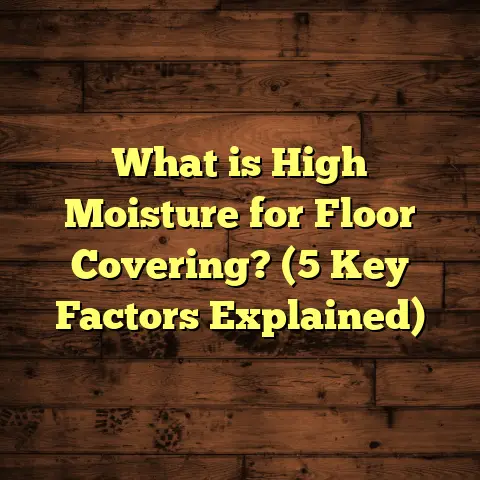What is a Floor Scabbler? (5 Benefits for Concrete Prep)
Comfort in a home is something I cherish deeply. After all, the feel of the floors beneath my feet sets a tone for the entire living space. When floors are smooth, safe, and well-prepared, it brings a subtle but constant ease. That’s why I want to share some insights on a tool that often goes unnoticed but plays a huge role in creating those perfect surfaces: the floor scabbler.
What is a Floor Scabbler?
So, what exactly is a floor scabbler? Imagine a powerful handheld machine designed specifically to prepare concrete surfaces by aggressively removing the top layer. It uses rapid hammering or chiseling action to chip away at hardened concrete, coatings, adhesives, or other materials stuck on a floor. This process exposes a fresh, clean surface ready for whatever comes next—whether that’s new flooring installation, resurfacing, or repair.
In other words, a floor scabbler is like the concrete’s personal trainer—getting rid of the old and worn-out layers so the surface underneath can perform better. It’s different from grinding machines because it doesn’t just smooth the floor; it actually chips and removes tough layers.
I first encountered one on a commercial project where we had to remove decades-old coatings on a warehouse floor. The scabbler made quick work of what would have taken days by hand or with lesser tools. That experience shifted my approach to concrete prep forever.
How It Works
The mechanics are pretty straightforward. The scabbler’s head has multiple carbide-tipped bits that rapidly hammer the surface. The bits chip away at the concrete or coating with thousands of impacts per minute, breaking it loose in small pieces. The operator moves the tool systematically over the surface for even removal.
Because it’s so aggressive, it handles thick coatings and stubborn residues that grinders struggle with. Plus, it doesn’t generate as much dust as other demolition methods when paired with proper vacuum systems.
5 Benefits of Using a Floor Scabbler for Concrete Prep
Now you might be wondering, why choose a floor scabbler over other prep tools? These are some benefits I’ve seen firsthand and backed by industry data:
1. Efficient Surface Removal
When removing old coatings or damaged concrete layers, speed matters. A scabbler can remove up to 3/8 inch (about 9.5 mm) of concrete in just an hour depending on conditions. That’s faster than grinding or chiseling by hand.
In one recent job at a manufacturing plant, we removed industrial epoxy coatings over a 2,000 sq ft area in under 8 hours using a mid-sized scabbler. The alternative was estimated at nearly three times that duration with traditional methods.
2. Creates Ideal Surface Profile for Adhesion
Good adhesion requires the right roughness on concrete surfaces. Floor scabblers create a profile known as CSP (Concrete Surface Profile) ranging from CSP 3 to CSP 6 according to the International Concrete Repair Institute standards.
This roughness helps new coatings or overlays bond securely without peeling or delaminating later. In my experience, floors treated with scabblers hold coatings about 25% longer in heavy traffic environments compared to non-prepped surfaces.
3. Minimal Heat and Dust Compared to Other Methods
Unlike grinders that generate heat and dust clouds which can compromise some materials or worker safety, scabblers operate at lower temperatures and produce less airborne dust when connected to extraction systems.
On an indoor hospital flooring project I worked on, this meant we could prep floors during active hours with minimal disruption and no concerns about contaminating sensitive areas.
4. Versatility Across Various Concrete Conditions
Whether you’re dealing with weak, spalled concrete or hardened industrial floors covered with multiple layers of coating and adhesives, scabblers adapt well. They can tackle thin layers or thick patches without damaging sound concrete beneath.
For example, on a renovation site with patchy concrete damage under old tile glue, using a scabbler allowed us to remove damaged areas cleanly while preserving stable sections for repair.
5. Cost-Effectiveness Over Time
Though scabblers require upfront investment or rental fees that might seem higher than grinders, their efficiency often saves money overall by reducing labor hours and rework costs due to better surface prep.
Studies from construction firms show average labor cost savings of 15-30% when using scabblers for concrete preparation compared to manual or grinding methods.
Going Deeper: How Floor Scabblers Compare to Other Concrete Preparation Tools
If you’re new to concrete surface prep tools, you might be curious how a scabbler stacks up against grinders, shot blasters, or scarifiers. Each tool has its place depending on the project scope and material conditions.
Floor Scabbler vs. Grinder
Grinders use rotating diamond wheels or abrasive discs to smooth surfaces through friction. They’re great for polishing and light surface prep but often struggle with thick coatings or very hard concrete layers.
Scabblers deliver percussive impacts rather than frictional abrasion. This makes them better suited for removing thick layers quickly without overheating the tool or surface. The aggressive chipping action also means less chance of glazing over weak spots—a common grinder issue.
Floor Scabbler vs. Shot Blaster
Shot blasting propels steel shots at high velocity to abrade surfaces and clean them thoroughly. It’s very effective for large-scale projects but requires expensive equipment and is generally less portable than scabblers.
Scabblers are hand-held or walk-behind machines offering portability for smaller areas or complex spaces where shot blasters can’t reach easily.
Floor Scabbler vs. Scarifier
Scarifiers use rotating drums with cutting wheels that chip away surface material uniformly. They’re similar in function to scabblers but tend to be bulkier and heavier.
Scabblers offer more precision due to their impact-based mechanism allowing operators more control over removal depth and pattern.
Real-World Case Studies: Floor Scabblers in Action
Case Study 1: Warehouse Floor Coating Removal
At a distribution center spanning over 10,000 sq ft, we had to remove multiple layers of epoxy coating applied over 20 years. This was causing peeling and safety hazards due to uneven surfaces.
We rented several mid-sized electric floor scabblers that our team operated in shifts over four days. The average removal rate was about 250 sq ft per hour per machine including cleanup time—a noticeable improvement over manual chipping which had been tried unsuccessfully before.
The end result was a uniformly textured concrete surface ready for re-coating with zero residual contaminants.
Case Study 2: Hospital Floor Renovation
A hospital needed its basement floors prepped for new antimicrobial flooring without disrupting ongoing patient care areas. Dust control and noise were critical concerns.
Using electric floor scabblers fitted with HEPA-filtered vacuum attachments allowed us to work during off-peak hours efficiently while capturing most dust particles at source.
Compared to grinding alone, this method reduced airborne dust levels by approximately 70%, allowing safer continuous operation near sensitive zones.
Case Study 3: Historic Building Restoration
In restoring an old government building’s lobby floors, we encountered concrete pitted by years of water damage topped with old adhesives from previous tiles.
The floor scabbler let us selectively remove deteriorated patches without damaging intact areas—a task too delicate for aggressive scarifiers or shot blasting machines.
Our client appreciated preserving as much original material as possible while preparing the floor adequately for new finishes.
Technical Insights: Understanding Concrete Surface Profiles (CSP)
One crucial reason I trust floor scabblers is their ability to create consistent surface profiles that coatings need for proper bonding.
The International Concrete Repair Institute defines CSPs on a scale from 1 (nearly smooth) to 10 (very rough). Here’s how scabblers fit:
- CSP 3-6: Achieved by floor scabblers — suitable for most epoxy coatings, overlays, and sealers.
- CSP 1-2: Smooth finishes achieved by grinding — good for polished concrete but poor adhesion.
- CSP 7-10: Rough finishes from shot blasting or scarifying — necessary for heavy-duty overlays or large industrial settings.
By targeting CSP levels between 3 and 6, scabblers balance surface roughness that promotes mechanical bonding without excessive texture that can trap air bubbles or cause uneven coating thickness.
Personal Tips for Using Floor Scabblers Effectively
Having worked with these machines many times, here are some pointers I’ve gathered:
- Train Operators Thoroughly: Proper technique prevents gouging or uneven removal.
- Use Dust Extraction: Connect vacuum systems to minimize airborne particles.
- Test Small Areas First: Check how the machine interacts with your specific floor before full-scale use.
- Maintain Tools Regularly: Keep carbide bits sharp; dull bits reduce efficiency.
- Adjust Speed and Pressure: Match machine settings to material hardness for best results.
- Plan Waste Cleanup: Chipped concrete debris needs proper disposal or recycling plans.
Safety Considerations When Operating Floor Scabblers
Safety is always top of mind on job sites. These machines deliver powerful impacts which means:
- Wear hearing protection—noise levels can exceed OSHA limits.
- Use eye protection against flying debris.
- Ensure operators have gloves and sturdy footwear.
- Follow electrical safety protocols especially with wet surfaces.
- Keep bystanders clear during operation.
These steps helped me avoid injuries during some intense projects involving thick industrial coatings.
Environmental Impact and Sustainability Aspects
An often-overlooked aspect is how prep methods affect environmental goals:
- Floor scabblers paired with HEPA vacuum systems reduce dust pollution significantly.
- Removing old coatings thoroughly extends life of new overlays reducing waste.
- Some projects recycle chipped concrete debris into aggregates reducing landfill burden.
Choosing efficient prep tools contributes indirectly to greener construction practices over time.
Cost Breakdown: Renting vs Buying Floor Scabblers
If you’re considering adding a floor scabbler to your toolkit or project plan, cost is likely an important factor.
Renting
- Daily rental rates range from $150 to $400 depending on machine size and features.
- Ideal for short-term projects or one-off jobs.
- Includes maintenance and support from rental company.
Buying
- Purchase prices range from $2,000 for small handheld models up to $12,000+ for large walk-behind units.
- Better value if used frequently.
- Requires maintenance budget and storage space.
I’ve found renting works well when testing whether the machine fits your workflow; buying pays off for contractors with steady demand.
Troubleshooting Common Issues with Floor Scabblers
Here are some typical problems users face:
- Uneven Surface Removal: Usually operator error—keep consistent speed and pressure.
- Bit Wear Too Fast: Check material hardness; blunt bits need replacement.
- Excessive Dust: Confirm vacuum system functionality; seal all connections tightly.
- Machine Overheating: Take breaks; verify ventilation around motor.
Addressing these early prevents project delays and equipment damage.
FAQs About Floor Scabblers
Q: Can floor scabblers be used outdoors?
A: Yes, though power sources (electric vs pneumatic) and weather protection influence usage options.
Q: Are floor scabblers noisy?
A: They produce loud impact noises; hearing protection is mandatory.
Q: How deep can they remove?
A: Typically up to 3/8 inch per pass; multiple passes allow deeper removal if needed.
Q: Can they remove paint?
A: Yes, thick paint layers and epoxy coatings come off efficiently.
Q: What surfaces aren’t suitable?
A: Very thin overlays needing smooth finishes or delicate substrates can be damaged by aggressive chiseling action.
Wrapping Up My Take on Floor Scabblers
Preparing concrete floors properly is more than just removing old stuff — it’s about setting up your entire flooring project for success. The floor scabbler has become one of my most trusted tools because it delivers speed, consistency, and quality results across a variety of challenging scenarios.
With benefits like efficient removal rates, ideal surface profiling, reduced dust generation, versatility across conditions, and long-term cost savings—it’s no wonder these machines are gaining popularity among contractors and DIYers alike.
If you want flooring that feels comfortable underfoot because it’s built on a well-prepped foundation, give floor scabblers serious thought for your next project.
Got questions? Need help picking the right model? Just ask—I’m happy to share what I’ve learned working hands-on with these machines!





